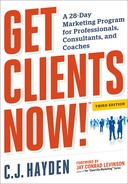You’ll Sell More If You Don’t Sell Anything
Michael Katz, www.bluepenguindevelopment.com
“An e-newsletter is the next best thing to having lunch with every one of your clients and prospects once each month,” declares Michael Katz, author of E-Newsletters That Work. “But what do you think would happen if every time you got together for lunch, you tried to sell those people something? My guess is they would stop having lunch with you.” Katz says,
The reason I bring up this lunchtime scenario is that when it comes to how you develop and manage your e-newsletter, there are a number of similarities. Your e-newsletter functions as kind of an electronic proxy for all those face-to-face interactions that can’t possibly happen in the physical world. It puts you in front of your target audience on a regular schedule, and in a nonthreatening context.
There are tangible, measurable, undeniable business benefits associated with relationship building. All those lunches, as nonlinear and unstructured as they may be, have results. But focusing on the desired result (i.e., more sales) at the expense of the relationship, eliminates both. If you use a relationship building opportunity to make a sales pitch, not only do you eat a lot of lunches by yourself, you also eliminate one of the easiest, most efficient means for growing your business. It’s certainly fine to talk about what you do, but you can’t make it the center of the conversation. As far as your e-newsletter goes, if it becomes nothing more than a telemarketing call in disguise, people will unsubscribe, putting an end to both the conversation and any related future opportunities.
Effective e-newsletters require that you turn the selling machine off. Like a cherished lunchtime companion, a good e-newsletter focuses on offering relevant, useful, interesting information to readers, with an emphasis on providing—not extracting—value.
You can also use your e-mail system to send pre-written e-mail messages automatically. For example, you can provide an instant reply to someone who requests more information while visiting your website. The advantage of using an autoresponse e-mail instead of displaying the same details on your site is that once someone makes a request via an autoresponder, you have her e-mail address and can follow up with her later.
The same autoresponder that provides an immediate reply to an inquiry like this can also be used to send a series of messages at pre-timed intervals after the initial inquiry. For example, if a prospective home buyer makes a request on a real estate agent’s site for additional details about some current listings, an autoresponder could send her three more messages after seven, fourteen, and thirty days, each one offering a new tip about home buying and another reason to choose that agent to help with her home purchase.
It’s a good idea to include a notice at the beginning of the series that lets prospects know you’ll be sending additional informational messages, and gives them a chance to unsubscribe immediately if they don’t wish to receive them. That way your prospects will be opting in to the series and you won’t offend anyone. You can send these same people occasional broadcast e-mails after your pre-programmed series ends. Just as with an e-zine, you’ll find that messages with useful content for readers will keep subscribers longer than those that simply deliver promotional messages.
Another type of broadcast e-mail you might send is posts from your blog, if you have one. As discussed in Chapter 7, you should provide a way for readers to stay up-to-date on your blog posts. This may be an automated system that e-mails them each post as soon as it is made, or you might choose to combine blog posts with other items and send them out as a broadcast.
To encourage people to subscribe to your e-mail list, you can offer a bonus for online subscribers. On your website, blog, or social media profile, or at networking events, speaking engagements, or trade shows, you can offer a bonus to people who agree to sign up for your e-mail list and receive your e-zine or broadcasts. Your bonus could be:
![]() An e-book, special report, case study, or white paper
An e-book, special report, case study, or white paper
![]() A tip sheet, online assessment, or survey
A tip sheet, online assessment, or survey
![]() Access to an audio, video, online resource center, or e-course
Access to an audio, video, online resource center, or e-course
![]() Invitation to an upcoming teleseminar or webinar
Invitation to an upcoming teleseminar or webinar
You should never subscribe someone to your e-mail list without his or her permission. First, an e-zine and e-mail broadcasts are most appropriately used as relationship-building follow-up tools, not as vehicles for filling the pipeline. The people you send your e-mails to should already know who you are. Second, the sending of unsolicited bulk e-mail is governed by various government regulations, most of which can be translated as “don’t send bulk e-mail to people who haven’t asked for it.” Third, subscribing your prospects to e-mail that they never asked for and have expressed no interest in is more likely to be considered an annoyance than a courtesy.
A much better approach to gaining subscribers is to routinely ask clients and prospects if they would like to subscribe to your list when you first make contact with them. When you first publish an e-zine or start sending e-mail broadcasts, most people on your pre-existing in-house mailing list will not be offended if you send a sample copy asking if they would like to become subscribers. But don’t subscribe them first, and ask them to unsubscribe if they don’t want it.
